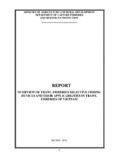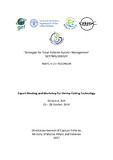| dc.description | In the situation that marine resources in the waters of the world are increasingly depleted, to help protect marine resources, many research on bycatch reduction devices to reduce trash fish for bottom trawlers have been carried out. Many different devices have been tested as square mesh codend, square mesh panels or steel frame JTEDs. Each device type has different advantages and disadvantages depending on fishing grounds and target species to select and use which devices are suitable and can achieve its objectives. Some countries have regulations for the bottom trawl vessels using JTEDs and BRDs to protect aquatic resources and endangered and threatened stocks. In Vietnam, JTED was firstly tested in 2001 and up to now there are some studies on this issue at different regions with many tested devices. In general JTED experiments in Vietnam were mostly trials at small scale and focus to evaluate escape ability through the devices by weight and number of individuals with just some of these can provide results on different of escape rate by species. Some devices have been proposed to use in fishing operations of trawlers such as square mesh panels with mesh size of 20mmand 30mm,square mesh codend with mesh size of 30mm and iron frame evice with bar’s distances of 20mm.However, these experiments have not consider to evaluate economic efficiency when these devices used and this is an interest of the most fishing communities whether or not they are willing to use or not. In general, JTED can be applied overwhelming on trawl fisheries of Vietnam because agreed rate to use JTED by fishers was 47 – 100%. Except fisher using small boat fishing shrimp in the coastal areas have refused to use this device because trash fish contributed a large amount of their total catch and economic income. Number of people who agreed to use JTED is proportion to vessel capacity with higher capacity then higher compliance ability. However, one issue that fishers all considered is the device must be applied for all fishing fleets. Juvenile accounted for from 46 – 54% of total catch of trash fish f trawlers in Vietnam and juvenile fish in total catch estimated was 233,877 ton/year (NguyễnVăn Lung, 2009). In order to protect this group, a legal document No. 02/2006/TT-BTS was established by former Fisheries Ministry on 20/3/2006. According to this legal document, mesh size at the codend of shrimp trawlers are from 20 – 30mm and 28 – 40mm for fish trawlers. However, in reality fishers usually use mesh size at the codend from 20 – 30mmand this sizes are too small to release juvenile fishes (LêXuânTài, 2005). Therefore, to release juvenile fishes, a technical measure is to apply a suitable JTED because this device can be the most effective to release bycatch and juvenile fishes in the case of Vietnam. | en |




